
 |
Eager Space | Videos by Alpha | Videos by Date | All Video Text | Support | Community | About |
|---|
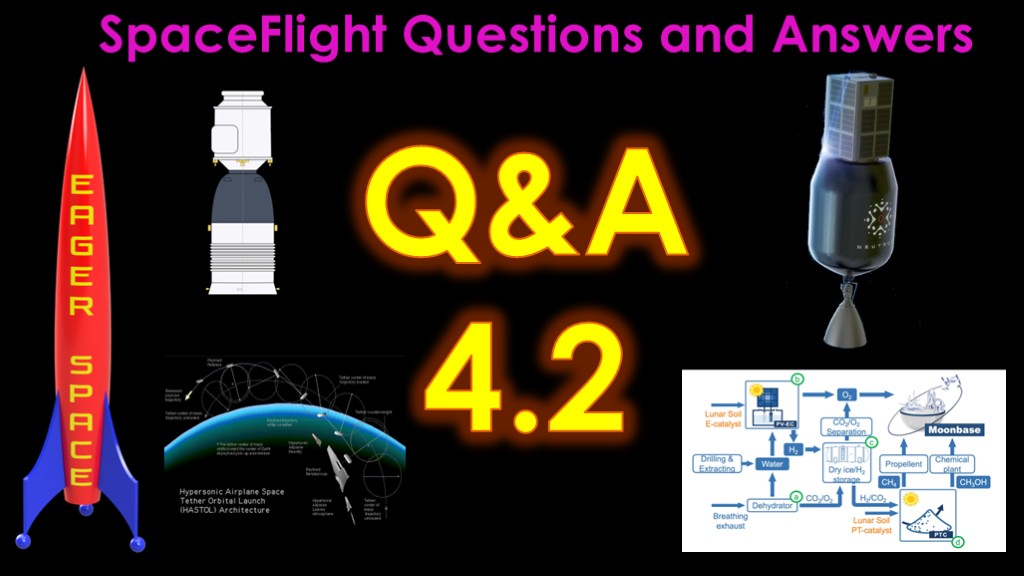
https://www.reddit.com/r/askscience/comments/ukzfir/why_do_ion_engines_prefer_high_molecular_weight/
Welcome to spaceflight questions and answers, edition 4.2

Thanks to everyone who asked questions.
Many of the answers are in videos that I've done in the past. You can find past videos by going to eagerspace.net and searching around.
Onto the questions
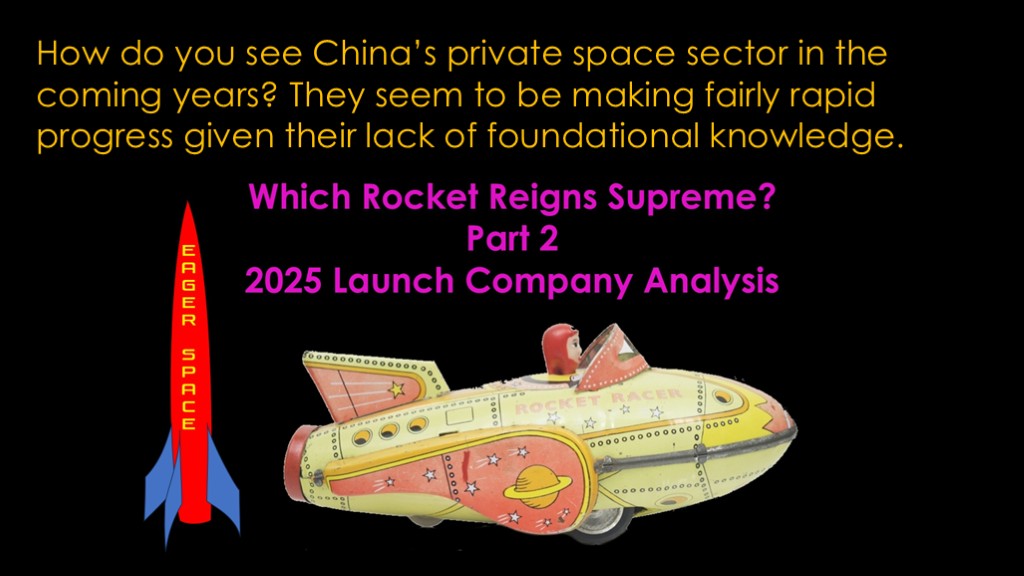
I get asked that often and I don't know enough about Chinese commercial space to have a meaningful opinion.
I linked to a few people who know a lot more near the end of this video.
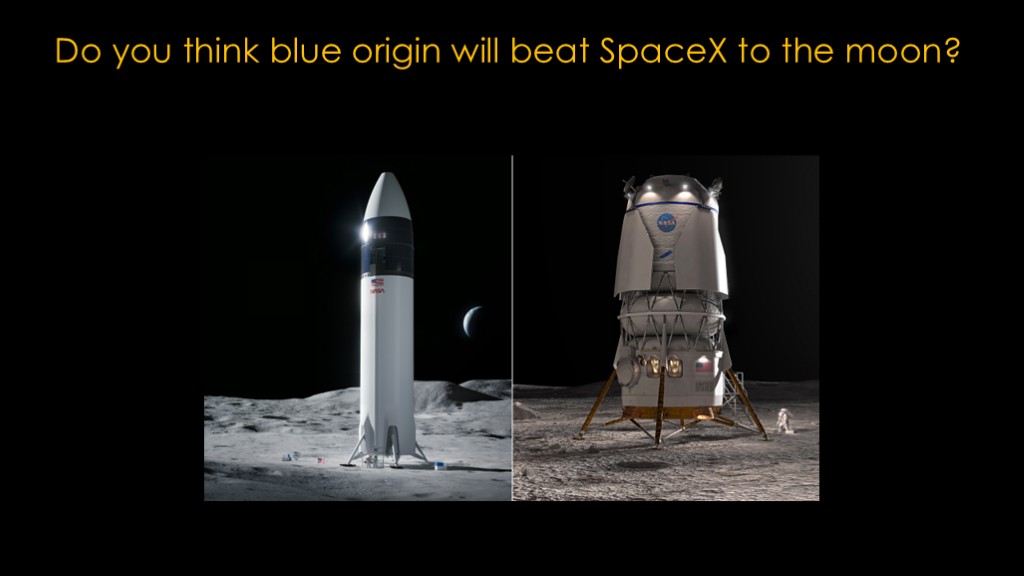
Two years ago I would have said "definitely not".
Today I would say "unlikely".
Starship is definitely in a bad state but SpaceX has a lot of money, a lot of experience, and a big team.
Blue Origin is still working hard to fly New Glenn more than once.
I'll also note that the lunar lander contracts aren't like crew or cargo resupply for ISS, where there were two companies competing to see who was first. SpaceX *has* the sole contract for Artemis 3 and 4 right now, and it's not clear if NASA can change that even if Blue Moon is ready earlier.
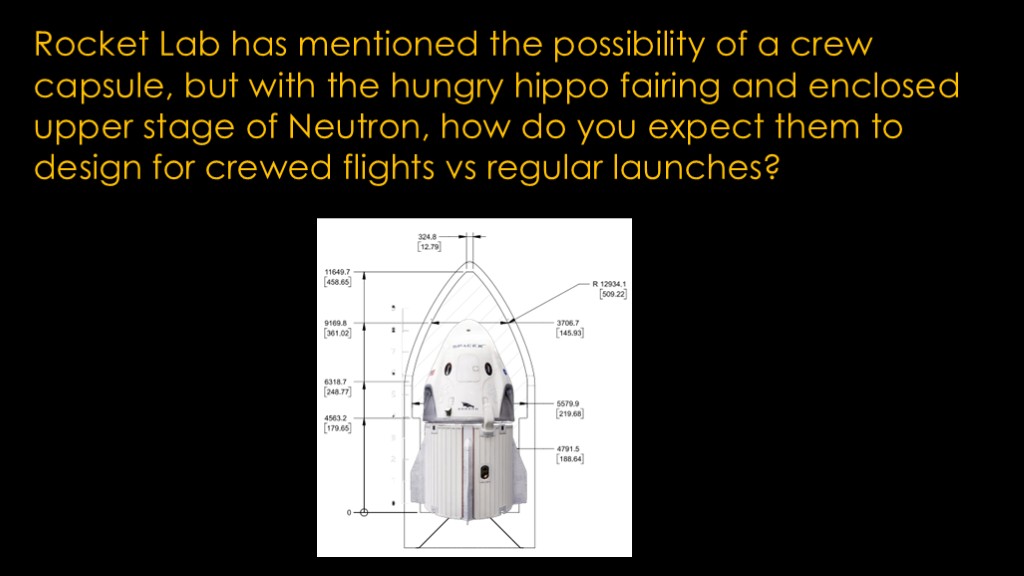
Crew on Neutron is definitely in the "if there was market we might do it" category, and right now the market is tiny and served by dragon.
Here's something that I found pretty surprising...
You can fit a crew dragon inside a Neutron second stage if you can fix the small issue of the fins on the trunk, so I think that there's no reason you can't put a capsule inside the current design.
For abort you just blow the fairings off and then trigger the abort engines in the capsule.
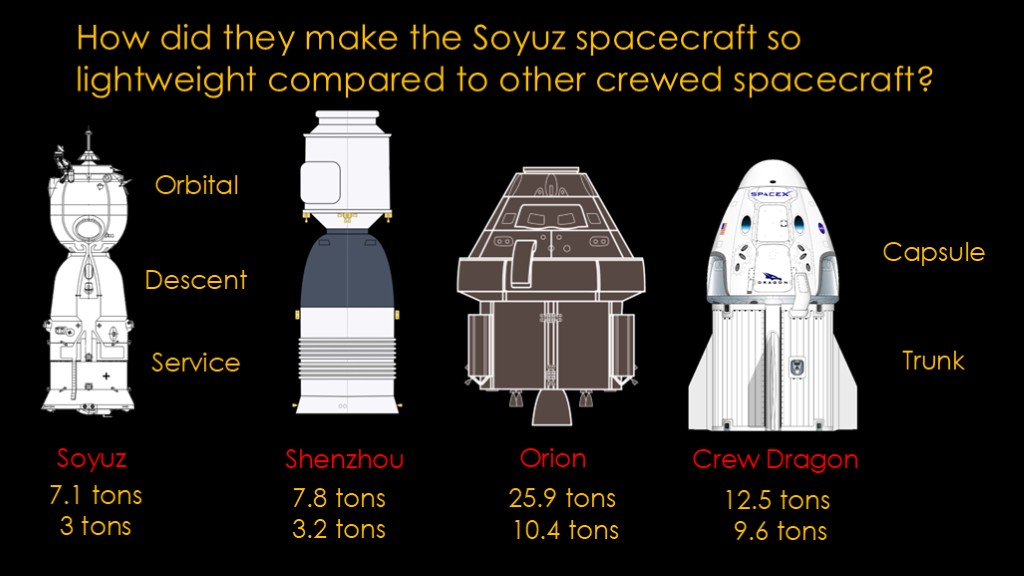
Interesting question. Let's look at some capsules.
The workhouse Russian Soyuz consists of 3 modules. The crew rides in the descent module on both launch and descent, the orbital module gives them more space when they are in orbit, and the service module at the bottom provides power, engines, etc. The descent module is the only part that returns intact.
The Chinese Shenzhou (shen-joe) capsule uses the same layout as the Soyuz - it's almost like the Chinese adopted the Russian design - but it is slightly upsized, with about a 25% larger diameter.
The US and European Orion capsule skips the orbital module but is much larger than the others.
And finally, the Crew Dragon looks like it has a service module, but the rear section is the hollow trunk. The trunk changes the aerodynamics so the capsule flies forward during abort, provides a location for the solar panels and radiators, and can carry unpressurized cargo inside.
As for size, the Soyuz launch mass is 7.1 tons and 3 tons of that returns.
The Shenzhou launch mass is 7.8 tons and 3.2 tons of that returns.
The Orion is a beast, with the capsule massing 10.4 tons by itself and the service module massing 15.5 tons, for a total of 25.9 tons. It's intended to be a capsule that astronauts can stay in for the long lunar missions and the service module has enough propellant to get into and out of lunar orbit. It's still very portly.
Crew Dragon has a total mass of 12.5 tons but returns 9.6 tons to the ground.
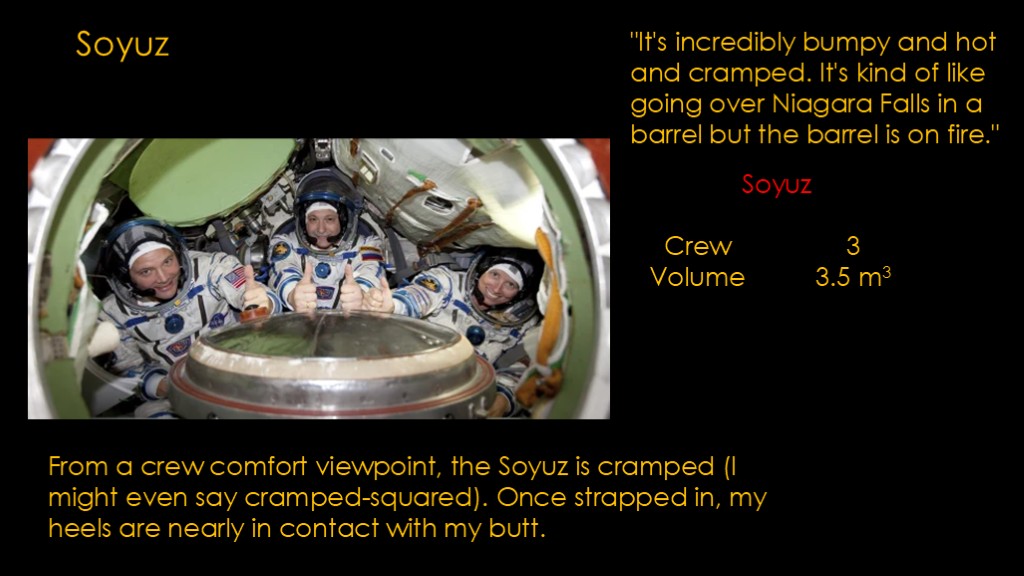
Now let's look inside.
The Soyuz carries a crew of 3 but has only 3.5 cubic meters of interior volume.
Quite a few astronauts have flown on Soyuz; here is what two of them said...
Astronaut Don Pettit said (read)
Astronaut Doug Wheelock said (read)
It's bad enough that the crew sometimes takes strong pain relievers before the flight to help deal with the muscle cramps that result from the position.
The reason that Soyuz is so small and cramped is that the Soyuz rocket can only carry about 8.2 tons into low earth orbit, so the spacecraft is pretty much as big as it could be.

The Shenzhou capsule also carries three, but it's much larger at 6 cubic meters. You can see that there is considerably more space than Soyuz.
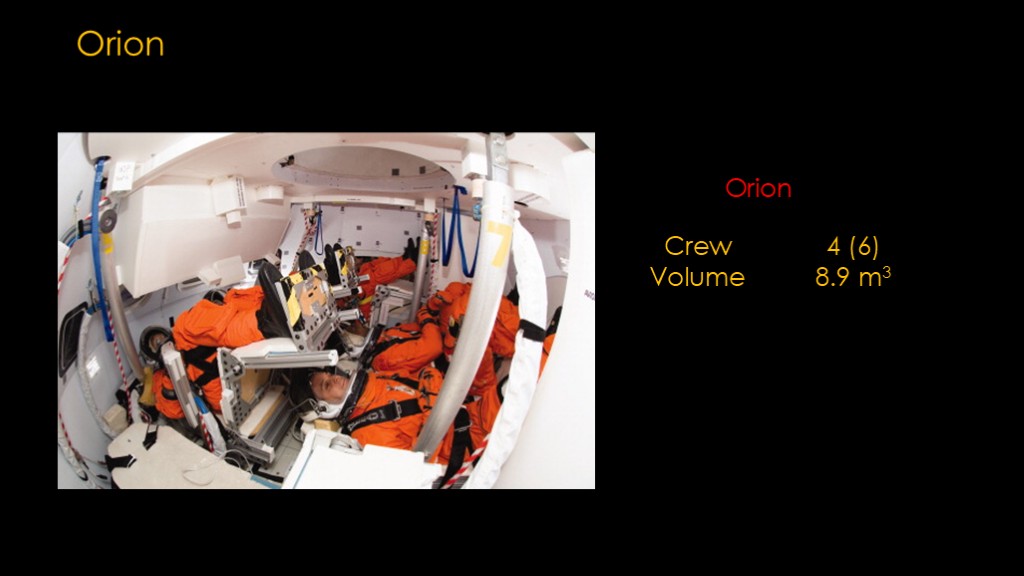
Orion is designed to carry up to 6 crew but is currently only planned to fly with 4. The two-row arrangement means some crew members have feet over the heads, and the capsule has a palatial 8.9 cubic meters of volume.
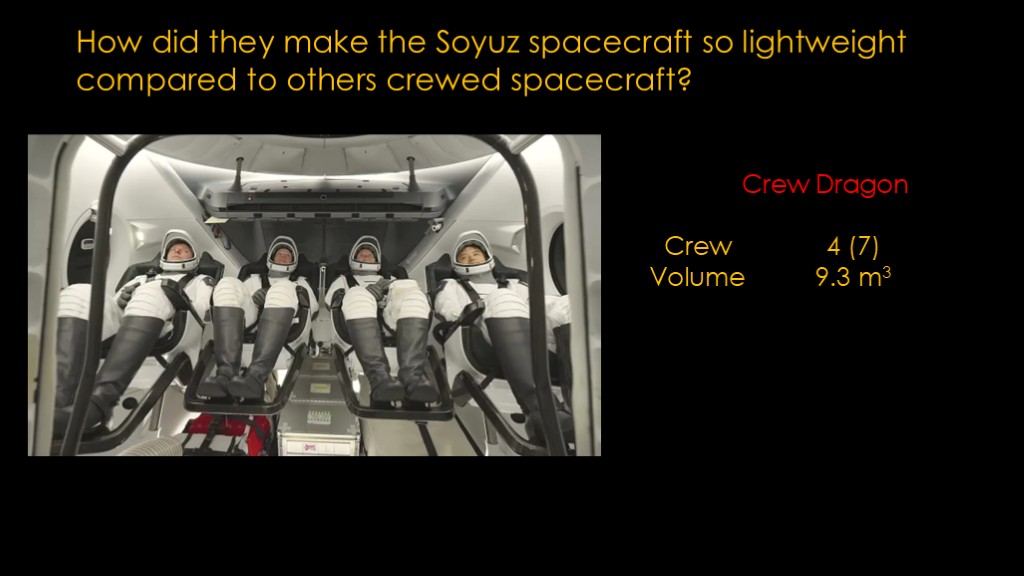
And finally, Crew Dragon is sized to carry up to 7 but normally carries only 4, and it has 9.3 cubic meters of habitable volume.
Discounting Orion - which is really doing a very different job - crew dragon is bigger and heavier than the Russian and Chinese capsules for two reasons.
The first is that it is designed for a larger crew, and the second is that it is reusable and brings the bulk of the launch mass back to the ground. More mass coming back requires a heavier and more robust heat shield.
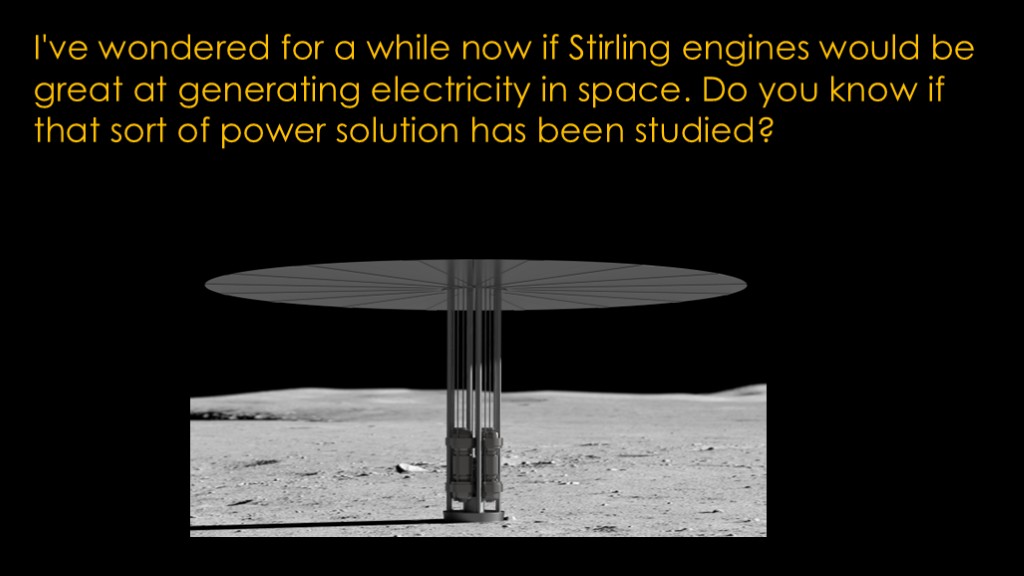
The small NASA kilopower reactors for lunar surface use are based on stirling engines. They need large radiators to get rid of the excess heat.
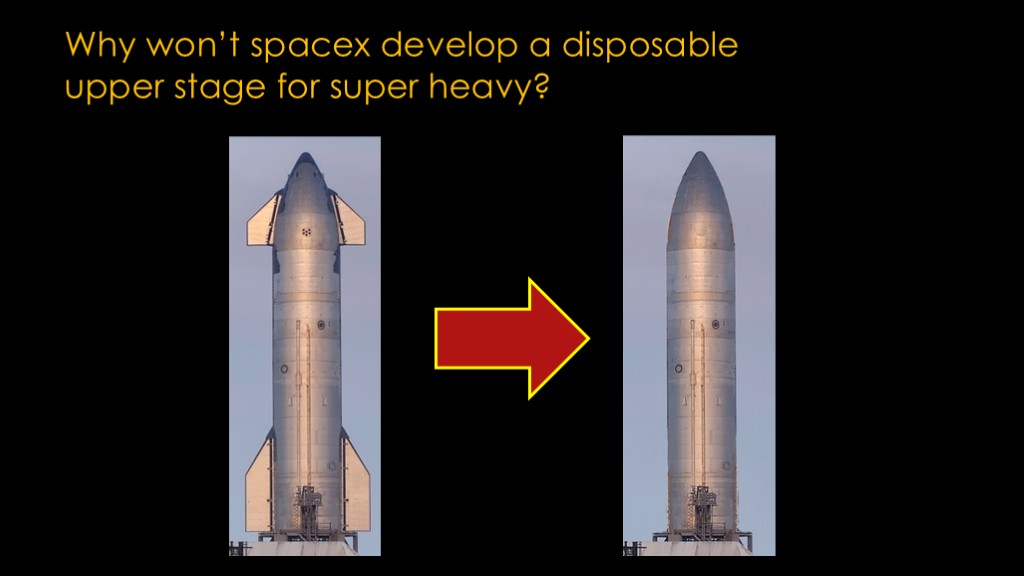
They have.
Just like there's a disposable Falcon 9 without grid fins or landing legs, take starship and get rid of the fins, all the heat shield tiles, and the landing fuel tanks, and you have a disposable Starship.
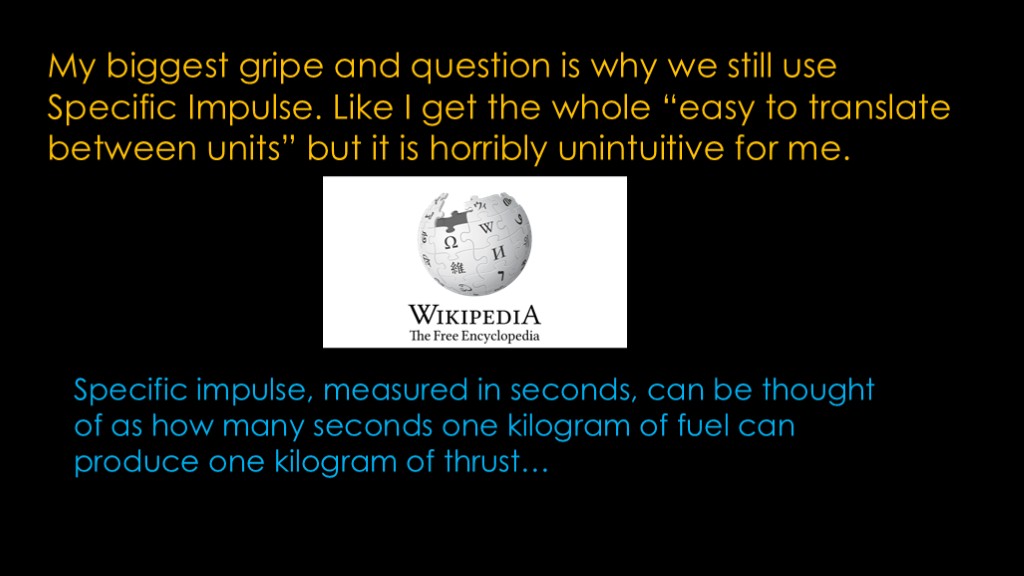
Wikipedia says the following about specific impulse in reference to rockets.
This definition has little utility - the rocket equation is based on exhaust velocity, which is far more intuitive in my opinion.
But we're stuck with specific impulse because it's what has always been used. Just use it as if it were dimensionless.

Yes.
Estimates for how many people do not have internet access range from 2.5 billion to 2.9 billion, or about 35% of the world's population.
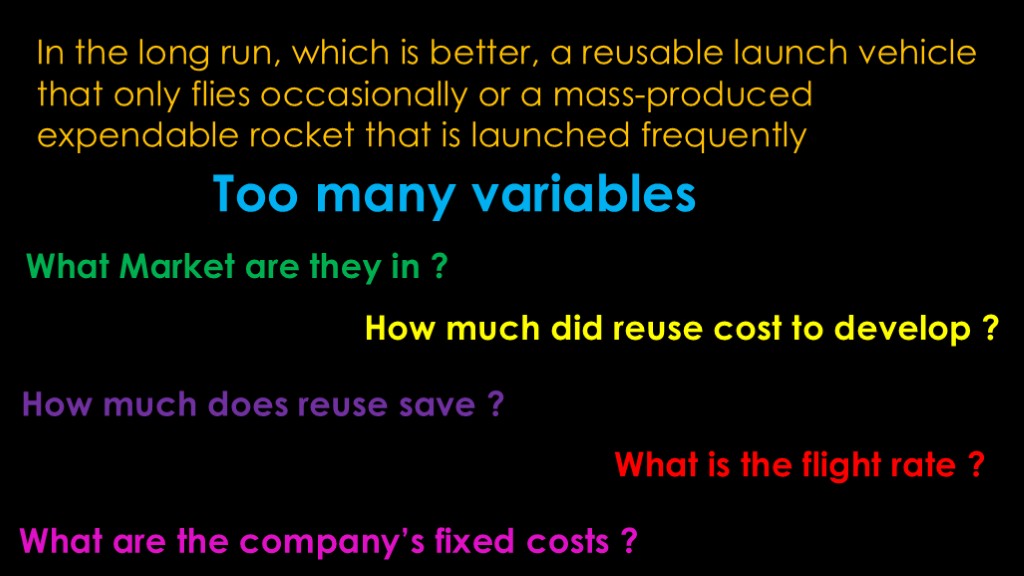
Too many variables to answer.
There are cases where reuse is hugely useful in terms of overall company aims - Falcon 9 is the obvious example here.
There are other cases where reuse makes little sense - Vulcan is an example of this right now.
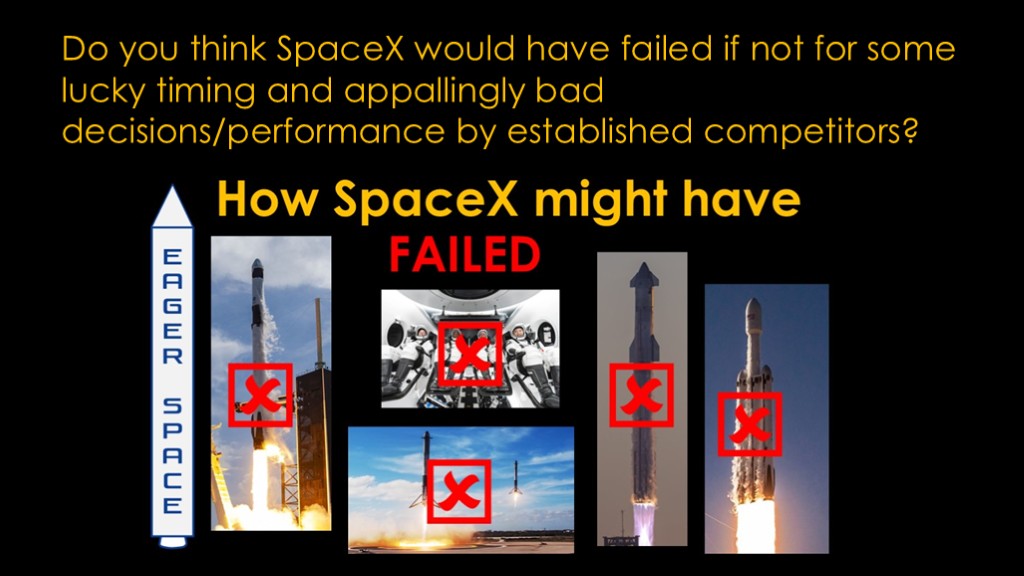
Absolutely. Here's a video for you.
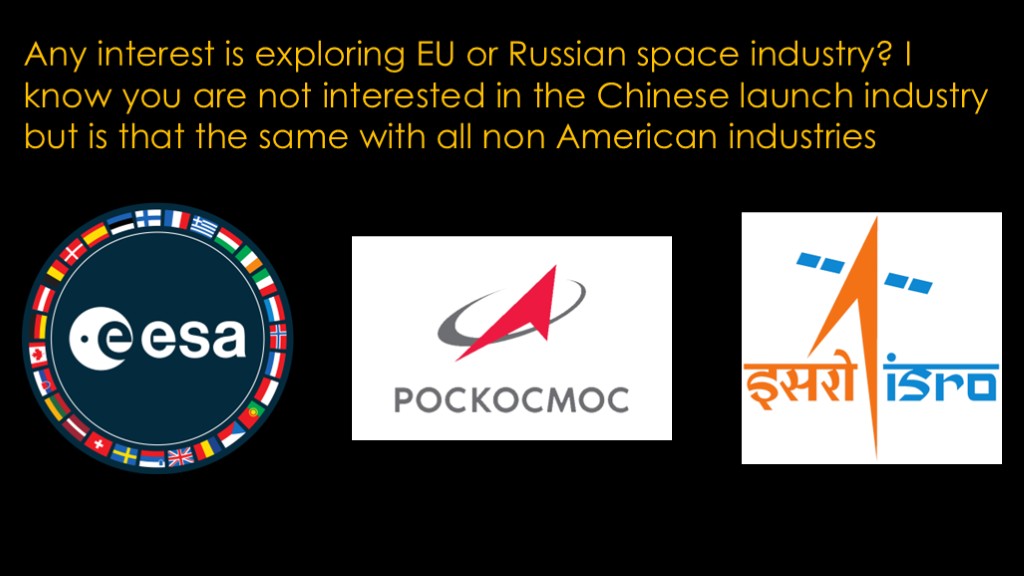
I've talked a little about the EU space program. Russia is hard to talk about because none of their official information is trustworthy and you therefore need insider sources, which I don't have.
I've talked a little about India's ISRO, and will probably talk about it more in the future.
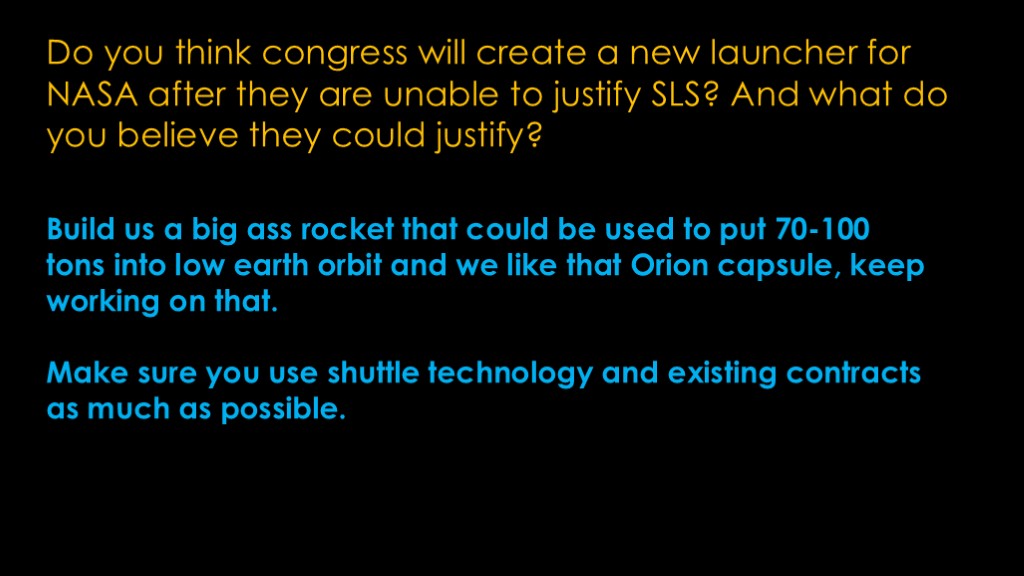
Congress has never felt the need to justify SLS and I'm not sure they would change that post SLS.
The space act of 2010 that create SLS pretty much said the following (read)
They talk about deep space but they never define a specific mission.
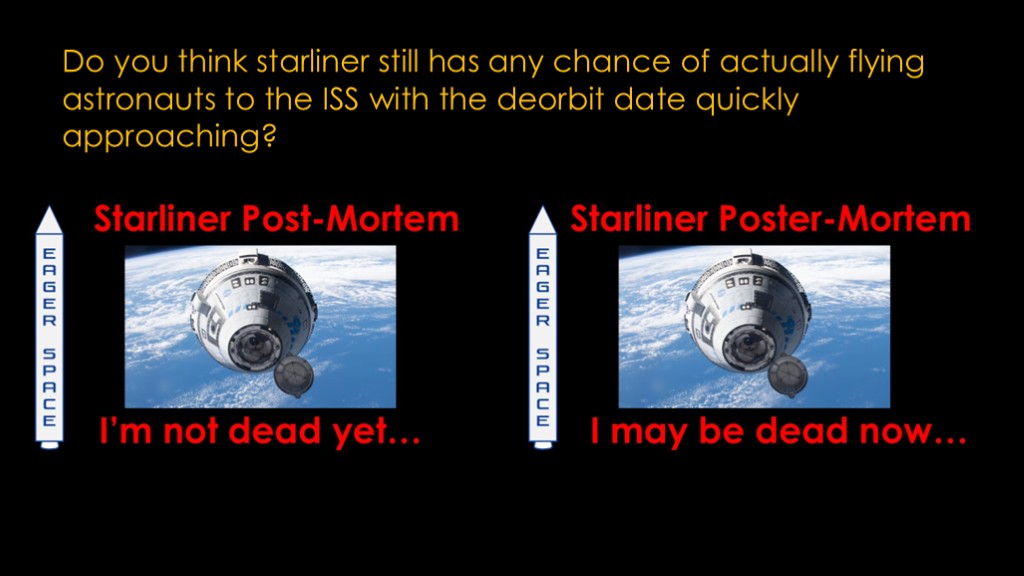
After the early issues I thought that starliner still had a good chance, and then after the one way crew flight and Boeing's other issues I felt strongly that there wasn't a good business case for it.
Boeing has since then sold a bunch of new stock and they've been working on a thruster redesign so I'm not sure anybody should care about my opinion now...
The longer they wait, the less money there is in the ISS contract and it's not clear what post-ISS business there might be from the "I hate dragon" contingent.
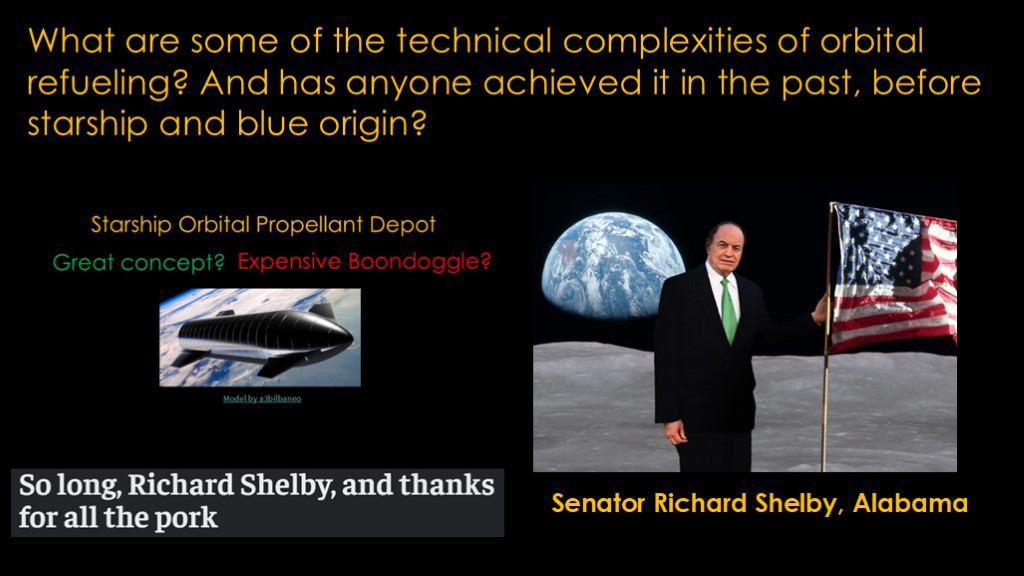
I talk about propellant depots in this video.
From a technical standpoint, orbital refueling isn't a big challenge. It hasn't been done in the past because nobody wanted a mission architecture that required a propellant depot.
As for why NASA hasn't done it, Eric Berger shared this quote about Alabama senator Richard Shelby, "Senator Shelby called NASA and said if he hears one more word about propellant depots he's going to cancel the space technology program".
NASA's Marshall space flight center is in Alabama and it owns - among other things - management of the SLS rocket.
Berger wrote an article for Ars Technica titled, "so long, Richard shelby, and thanks for all the pork" that goes into more detail.
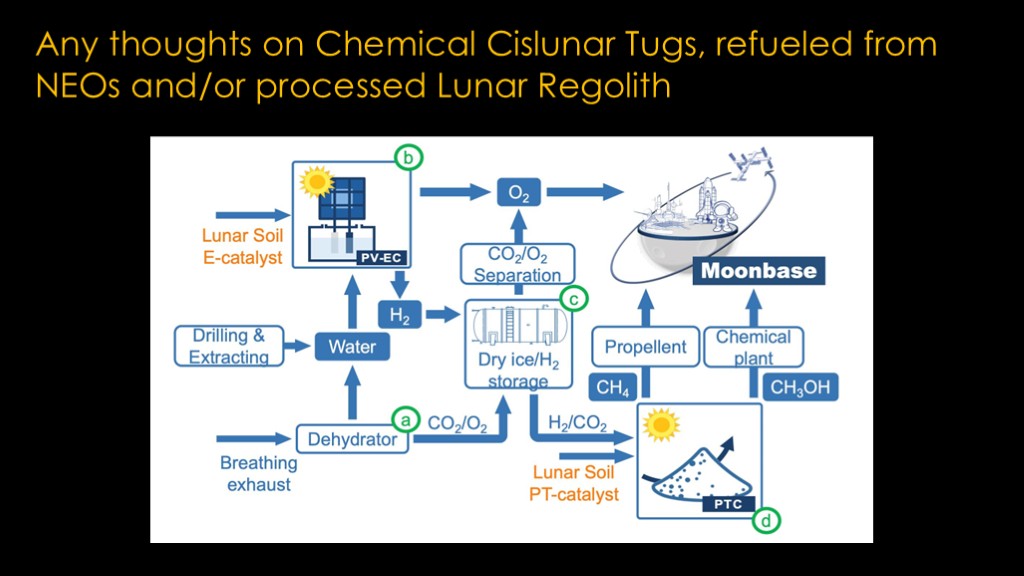
Two questions come to mind.
The first is "what sort of market is there for cislunar tugs?" That seems very hard to predict.
The second is "how much it will cost to research, design, develop, transport, and operate facilities that can do that and can you build a business around it?"
There are certainly technical challenges, but the big question is "who is going to pay to do it and why?"
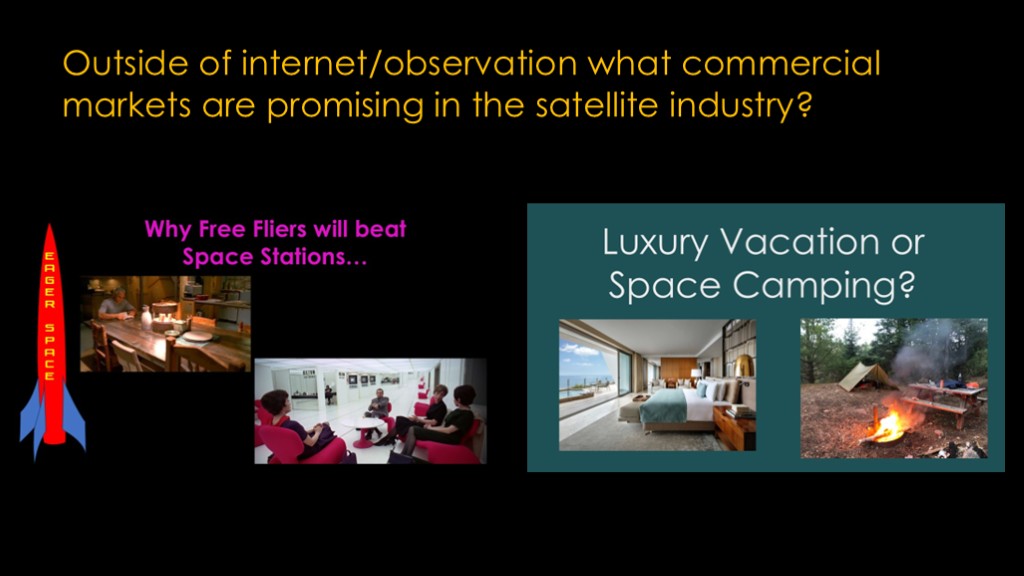
NASA has tried to answer this question with ISS for years and hasn't really come up with any real answers.
I talk about it a bit in my free fliers video. My short answer is that there might be something related to manufacturing but it's too soon to tell. I don't think there's a meaningful market for tourism even if transportation is much cheaper.
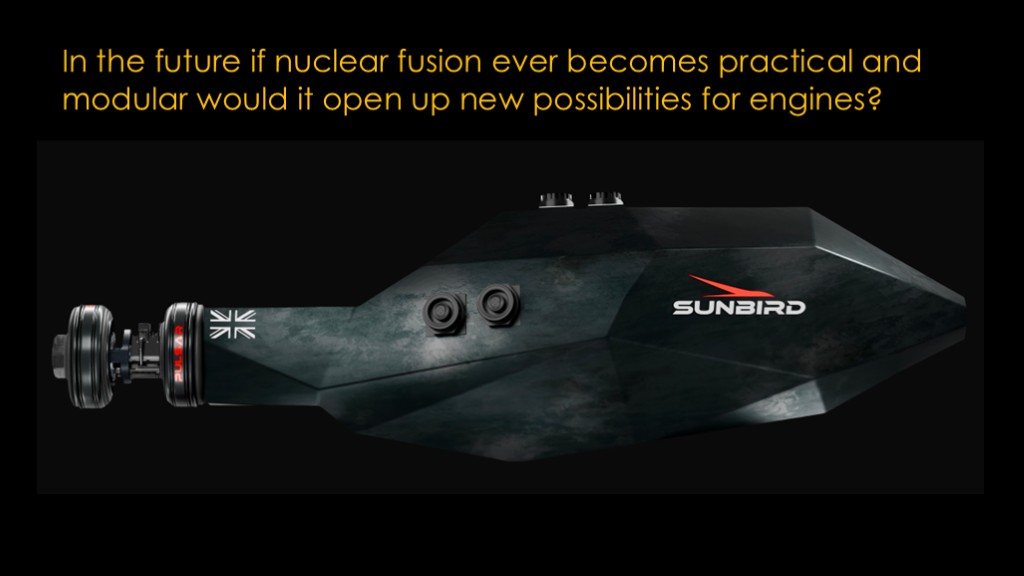
There are many fusion rocket engine designs floating around, including the sunbird from Pulsar Fusion.
It is possible that they can work, and if they do, you can just let the products of fusion - or at least some of them - escape out the back. That gives you really high specific impulse. Whether it gives you enough thrust to be interesting isn't clear right now.
The big problem I see is that you need a *lot* of power input to get a fusion reaction started. If you use inertial confinement, you need a ton of power to drive your lasers, and if you use magnetic confinement, a ton of power to heat the plasma and perhaps to get your magnets up and running.
That's not a problem for a terrestrial power plant, but it seems to be a significant barrier for a spacecraft.
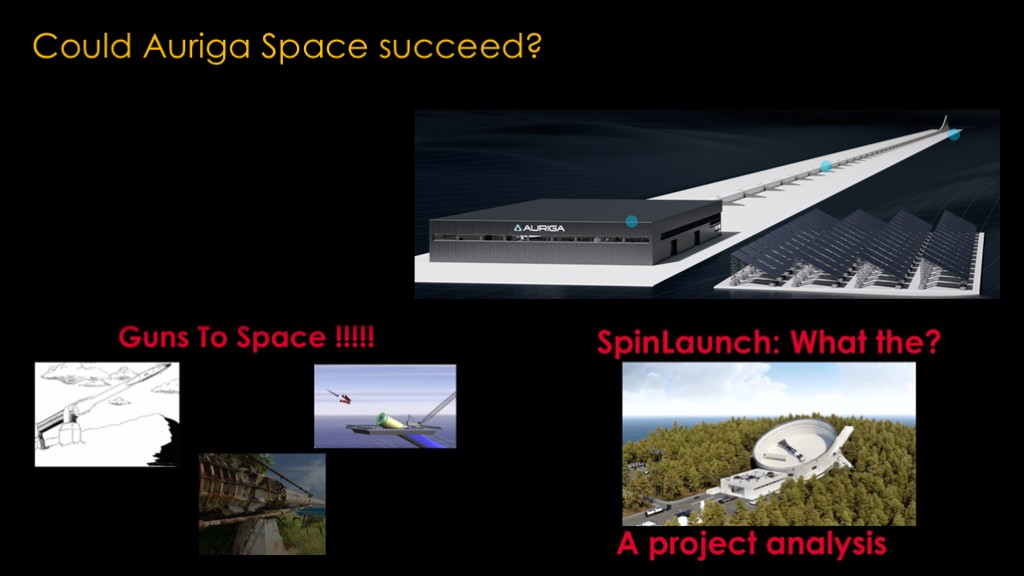
Auriga is trying to use electric propulsion to do hypersonic testing, suborbital launches, and ultimately orbital launches.
I talk about electromagnetic launchers in my "guns to space" video.
It's theoretically possible, but you have many of the same issues that SpinLaunch had.
You need to design payloads to be very resistant to high G loads, deal with heating and noise as they travel through the atmosphere at high speed, and you are going to invest a ton of money into development before you get any customer money back.
They can probably get to hypersonic testing for some values of "hypersonic". The suborbital market doesn't have a lot of money in it except for space tourism and this launcher can't carry people.
I think it's unlikely they get to orbit.
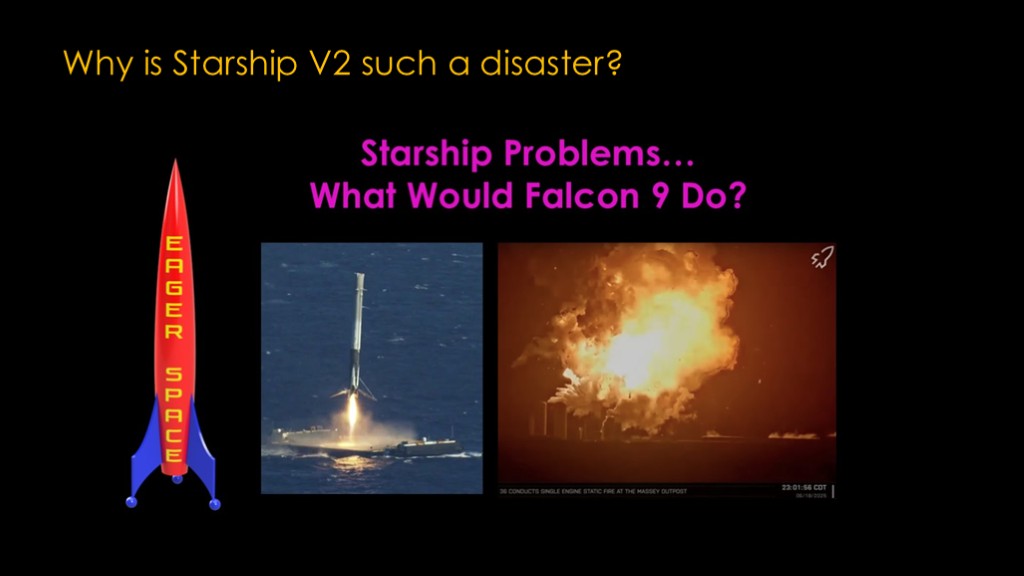
Here's a video for you....
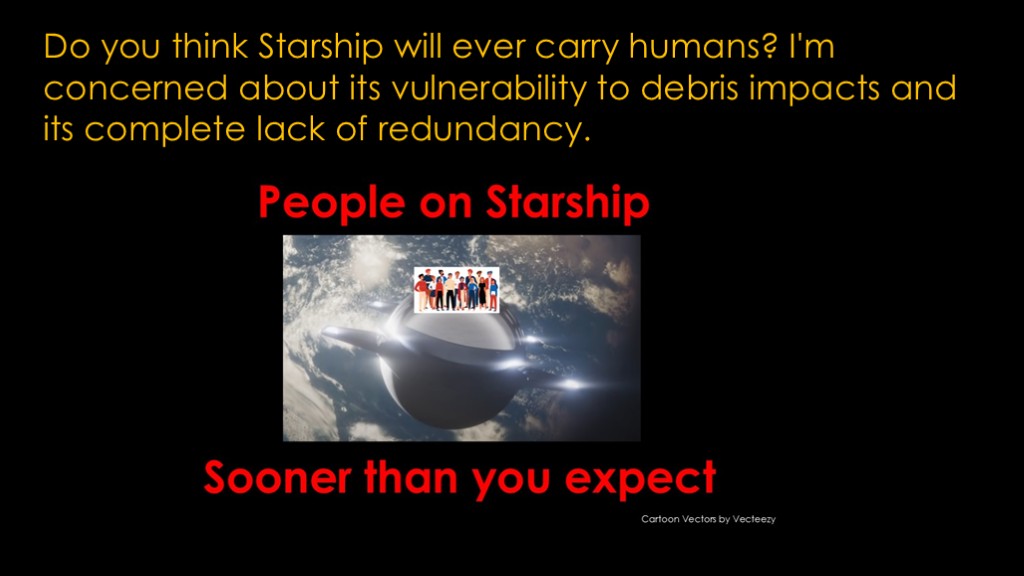
This video is a bit out of date but my thoughts are mostly the same.
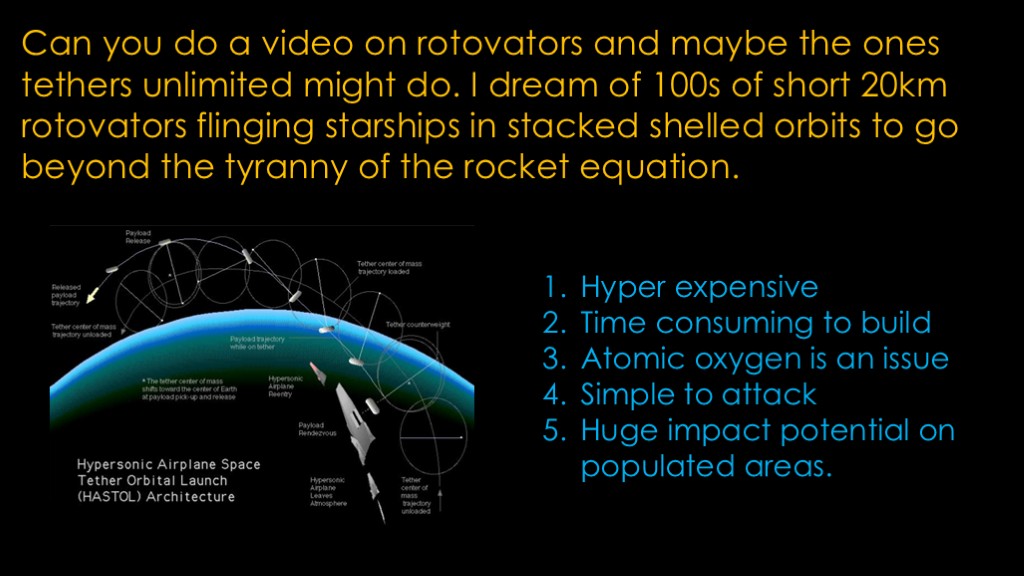
A video on non-rocket spacelaunch is somewhere on my topic list, but it's honestly not very high on the list, as I struggle to see how they might ever be practical.
They generally are:
Hyper expensive
Time consuming to build
The effect of atomic oxygen on them may be an issue
Simple to attack
And if anything happens to them they may deorbit directly on top of a populated area.
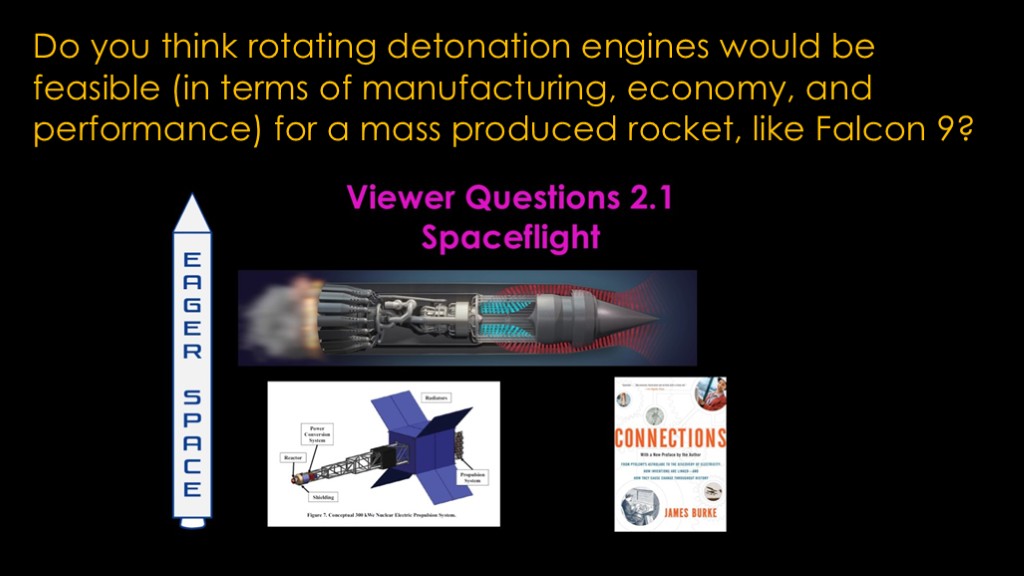
There's a short answer in this video.
I'm skeptical and there isn't much real data out there. I put them in the same class as aerospike engines, though I'm pretty
sure that aerospikes aren't practical and not sure about RDE engines.
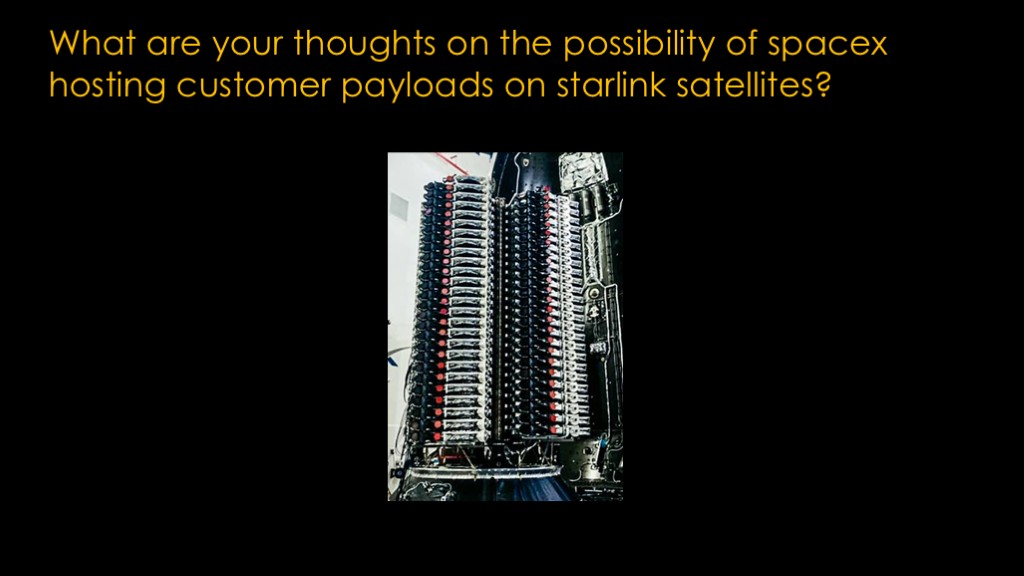
It's going to depend on the scenario - what a customer wants to do, how that would impact the satellite design, and how much they are willing pay for the capability. And whether their business model works in the long run.
There's a pretty high barrier - Starlink needs to be very reliable and they need to be spending the vast majority of their mass budget on serving their actual customers.
Probably not.
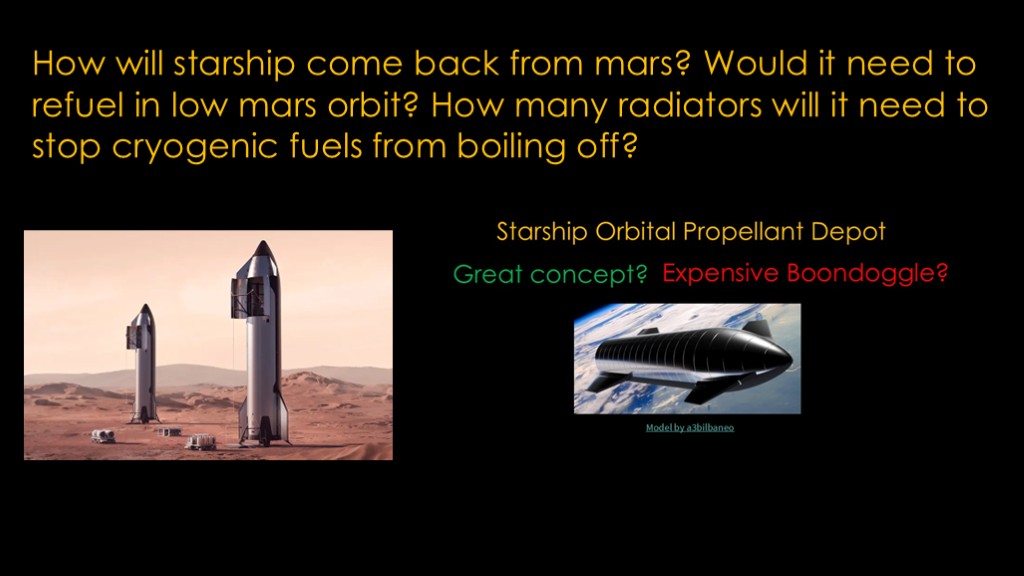
It's much easier to get from the surface of Mars into orbit than from earth because of the lower gravity and lack of atmosphere. A fully-fueled starship can do it, assuming that the design works out the way I expect it to work out.
If you are not making fuel on the surface, it would be better to refuel in orbit - you don't want to drop fuel to the surface only to bring it back up into space.
As for radiators, see my propellant depot video. I don't think keeping the propellants cold is a major issue, and they have to do some of that going to mars anyway.
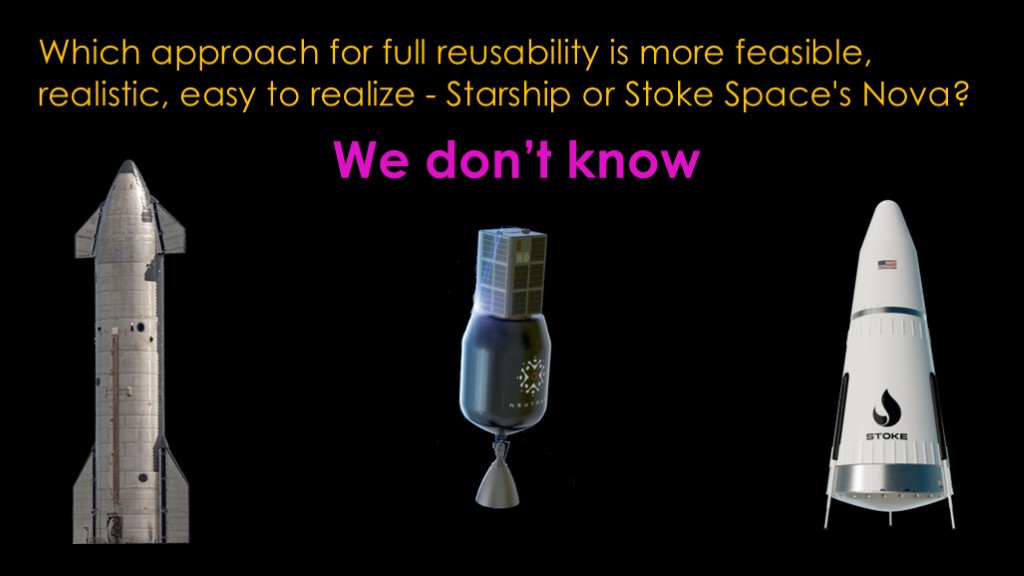
That's easy.
We don't know. Both approaches are under development and they are both trying to do things that have never been done. SpaceX has clearly run into some issue along the way and it's likely that Stoke will also run into issues along the way.
And it's not clear that full reusability is going to be the winner as it imposes a significant payload penalty. Maybe the "stupid cheap second stage" approach that Neutron is taking will turn out to be better.
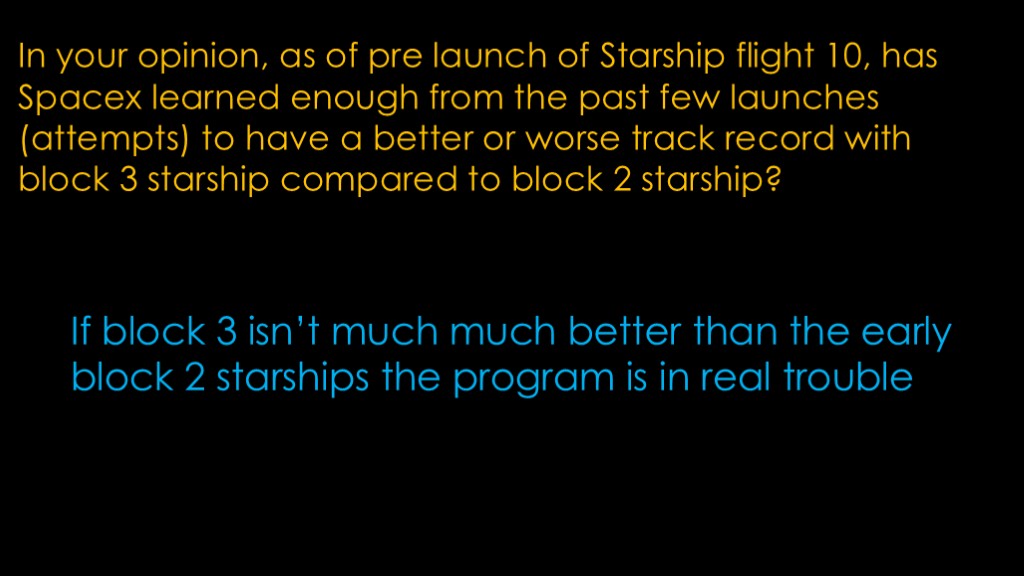
It's post flight 10, which was successful, but my opinion is still the same.
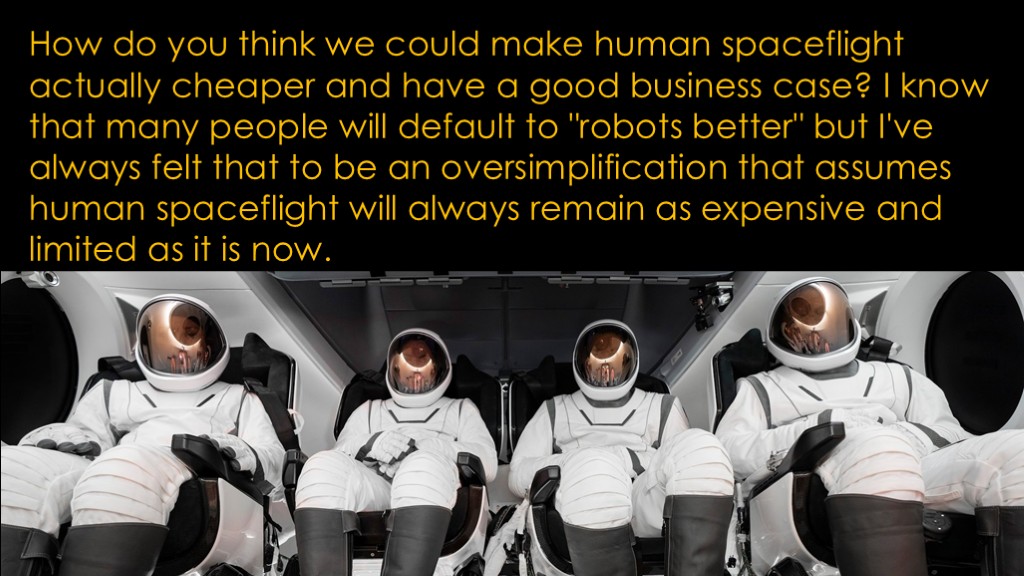
It's all about the markets. If you have a compelling reason for people to do useful things in space, that is useful-sized market, and somebody will serve that market.
Right now - with Dragon costs - there's a market for about 4 people a year to go into orbit, and it's costing on the order of $50 million per person.
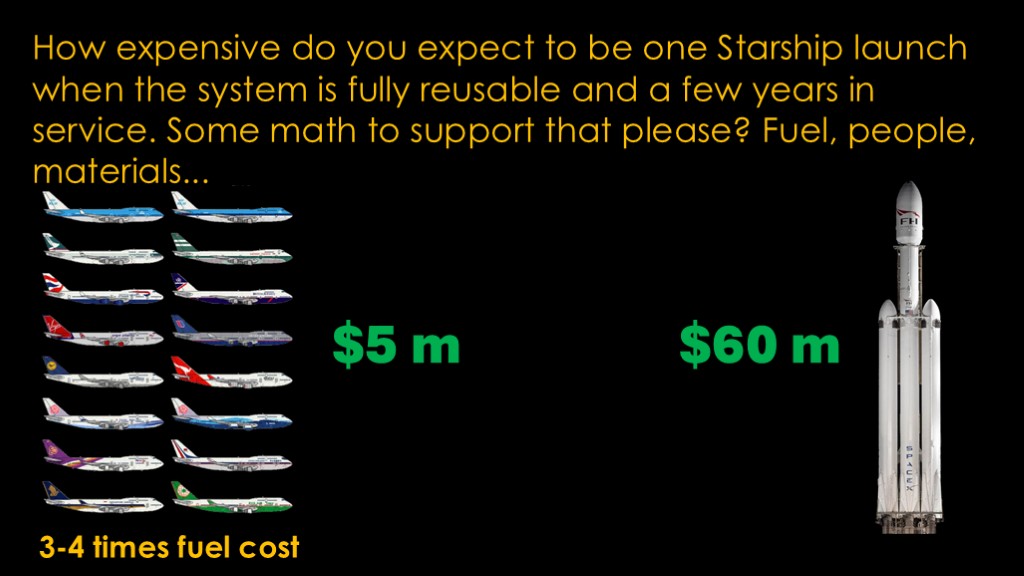
Interesting question.
You will find various people making assertions around how much starship will cost and how much payload it will carry. I made some predictions early on and I do still have a Starship model but I don't think anybody outside SpaceX has data that is good enough for estimates. I'm not even sure that SpaceX has good enough data for estimates .
But that's unsatisfying, so let's see if we can put in some bounds...
At the low end, commercial airlines operate at 3-4 times fuel cost. Fuel is supposedly roughly $1 million, so let's say the lower bound is $5 million. Starship probably doesn't have passengers to deal with, which makes it simpler, but many airliners spend half their lifetime in the air and that spreads out the fixed costs and the plane costs over many many flights. So I think $5 million is in the right ballpark.
On the high end, the heaviest Falcon is a decent benchmark, and that probably costs SpaceX around $60 million.
I'd say somewhere between the two. I'm confident on the low end, not so confident at the high end.
And note these are costs, not prices.
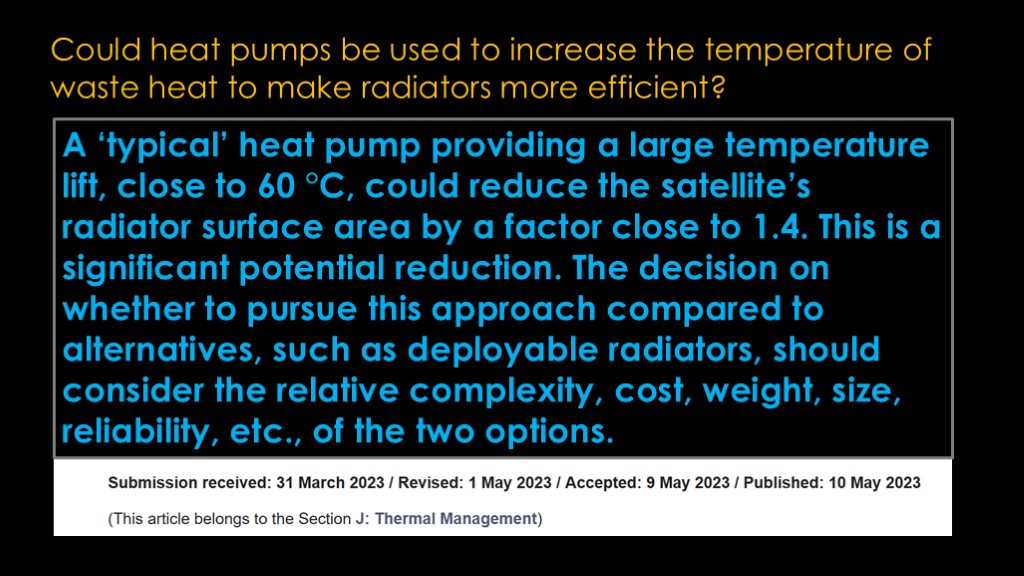
Here's a paper for you to look at. It says:
To summarize, you can reduce the radiator surface area by about 40%, but the system is more complex and you will pay to launch the heat pump and power it.
And if it goes out, you have a satellite that no longer works.
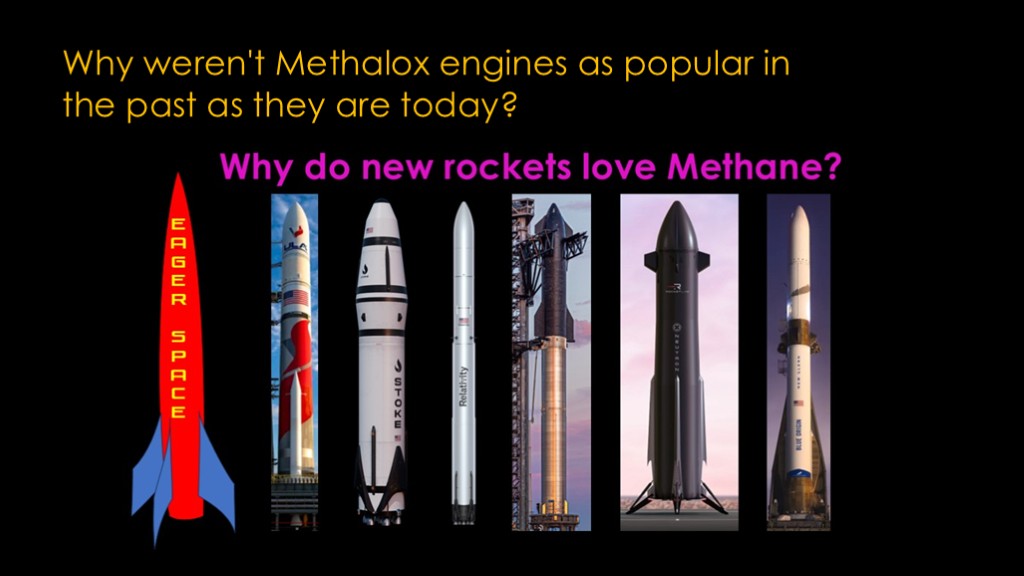
There's a video for that...
And that's all the questions and answers for this episode.

If you enjoyed this video, listen to this...